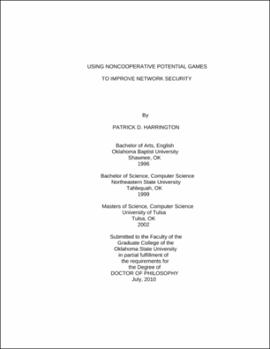| dc.contributor.advisor | Thomas, Johnson | |
| dc.contributor.author | Harrington, Patrick D. | |
| dc.date.accessioned | 2013-11-26T08:21:41Z | |
| dc.date.available | 2013-11-26T08:21:41Z | |
| dc.date.issued | 2010-07 | |
| dc.identifier.uri | https://hdl.handle.net/11244/6490 | |
| dc.description.abstract | Scope and Method of Study: | |
| dc.description.abstract | Our work puts forth a game theoretic global security mechanism to optimize security in a large heterogeneous network consisting of autonomous devices. Our work is applicable to a network that includes various computing devices such as PCs, cell phones, sensors, and control systems. Constraint satisfaction is used to fulfill the requirements of the differing computers in the network. Security metrics are used to quantify network security in a meaningful way. Attack tree analysis of the quantified security measurements is performed for decision making to maximize security by altering links that form the network. Coalitions of the computers forming the network are used to improve efficiency, as well as give a broader and greater overall security than would be possible in their absence. Side payments are used to induce a computer to move beyond its selfish motivations to benefit another computer. In keeping with noncooperative game rules, costs to form links are imposed only on the initiator of the link. | |
| dc.description.abstract | Findings and Conclusions: | |
| dc.description.abstract | Our solution is presented as a noncooperative weighted potential game using pure or mixed strategies. Findings showed that our game theory model of optimization improved overall security for heterogeneous networks, and demonstrated the viability of quantitative security analysis using metrics. Our game theory model of side payments and coalitions increased security by 10% in our experiments. Side payments more than doubled convergence time to optimal network security; however, side payments that were twice as effective in terms of security improvement reduced convergence time by 50%. Our game theory model of mixed strategies showed longer convergence time but overall improved security versus our pure strategy model. Findings also demonstrated that our game theory model of optimization improved security for networks of varying size. Through these solutions, our work presents a novel optimization technique that improves overall security for a heterogeneous network. | |
| dc.format | application/pdf | |
| dc.language | en_US | |
| dc.rights | Copyright is held by the author who has granted the Oklahoma State University Library the non-exclusive right to share this material in its institutional repository. Contact Digital Library Services at lib-dls@okstate.edu or 405-744-9161 for the permission policy on the use, reproduction or distribution of this material. | |
| dc.title | Using noncooperative potential games to improve network security | |
| dc.contributor.committeeMember | Hedrick, George | |
| dc.contributor.committeeMember | Park, Nohpill | |
| dc.contributor.committeeMember | Kletke, Marilyn | |
| osu.filename | Harrington_okstate_0664D_11045.pdf | |
| osu.accesstype | Open Access | |
| dc.type.genre | Dissertation | |
| dc.type.material | Text | |
| dc.subject.keywords | game theory | |
| dc.subject.keywords | network security | |
| dc.subject.keywords | potential games | |
| dc.subject.keywords | security metrics | |
| thesis.degree.discipline | Computer Science | |
| thesis.degree.grantor | Oklahoma State University | |
